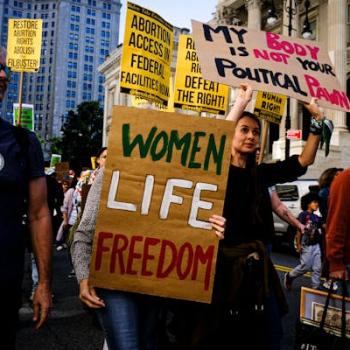“ERASMUS” ASKS:
Why do the religious authorities feel strongly about what we wear when we go about our daily lives, when we worship — or indeed when we swim?
THE RELIGION GUY ANSWERS:
One evening The Religion Guy was at the house of a physician who got an emergency summons to visit a hospital patient. Before departing, he took time to change from a polo shirt, ragged jeans, and sneakers into a dark suit, freshly starched white shirt, tie, and shiny shoes. I asked why bother. He explained that no matter what he wears he’s fully focused on a medical problem, but a vulnerable patient cannot know this and needs visual reassurance.
Point is, clothing and related visuals are ingrained in human interactions, even in the highly individualistic United States. Judges always preside in robes, morticians wear somber suits, uniforms identify security personnel, prisoners or gang memers announce solidarity with tattoos, and teens’ fashions obey social expectations.
So it’s no surprise if many religions ask believers to signify their identity, heritage, devotion, or desired virtues in the same way. That’s the basic answer to the “why” question, but let’s scan some examples.
Religious traditions can provoke public disputes. At this writing Nebraska is discussing whether to cancel a law forbidding religious garb in public schools, which barred hiring of a Catholic nun. This obscure law from 1919 was part of the Ku Klux Klan’s anti-Catholic campaign. The AP reports 36 U.S. states had such laws at one time but now Pennsylvania is the only other state with one. In France, school disputes evolved into a nationwide ban on conspicuous religious garb, aimed especially at Muslim women’s headscarves, followed by a ban on their full face coverings as a security measure.
Faith groups typically define attire and regalia for official functions, whether prescribed robes for Eastern gurus or mitres for popes. Protestant preachers may wear suits or the female equivalent when leading worship (while megachurch preachers favor Technicolor shirts to signal user-friendly informality). We can leave aside clergy complexities since “we” in the question refers to ordinary lay folk.
“When we swim“? That brings to The Guy’s mind not only current feuds over Muslim women who cover up at beaches in France but a U.S. Protestant summer camp that continues to oppose two-piece swimsuits for the ladies.
The principle involved is sexual modesty in attire. Though widely ignored across the West nowadays this has been considered a virtue through human history, although defined variously. Sounds odd, but a New Tribes missionary who worked with a remote Amazon jungle people where everyone goes without clothing told The Guy that absolute modesty rules are observed.
Strict Orthodox Jewish wives wear wigs so only their husbands see their natural hair. Muslim men are always covered from navel to knee. However, there’s far more discussion about modesty codes for Muslim women.
The Quran teaches, “Let them draw their kerchiefs over their breasts and not display their adornment” except to husbands, close male relatives, children, female servants, or “male attendants free of desire” (24:31). Some conservatives instead translate this as women drawing “head covers” over their “neck slits.”
The strictest interpretation of this deems the face or even the hands as “adornments” that should be concealed except for eye slits (as with a burqa) when a married woman leaves the seclusion of her home (purdah). More commonly, Muslim women cover their hair and necks but not the face, and their arms but not the hands, and choose loose-fitting clothing that is not revealing. Though less rule-bound, devout Christian and Jewish women tend to avoid suggestive outfits.
“When we worship“? One example is the disappearing rule that women should wear a head covering in church due to a thorny Bible passage, 1 Corinthians 11:5-6 (“any woman who prays or prophesies with her head unveiled dishonors her head…”). This was an edict in Catholic church law but abolished in the 1983 revision. Feminists find the idea offensive because the Apostle Paul linked it with wives’ submission to husbands (“woman is the glory of man”).
Protestants typically ignored this practice. But New Testament Professor Daniel Wallace of Dallas Theological Seminary says till recently he thought the older Catholic literalism on this had merit, but only when women actually pray or speak during public worship. He now thinks an actual head covering isn’t necessary in the modern context but women should display some symbol, for instance a wedding ring if they’re married.
“Our daily lives“? Jewish men’s kippah (skullcap) designates devotion to God because priests once wore headgear but the faith democratized when the Temple was destroyed and all men gradually adopted the practice. Many Christians wear a crucifix or cross necklace. Egypt’s Coptic Christians proclaim communal identity with small tattoos of the cross on their wrists; unfortunately that has marked them out for persecution by Muslim extremists.
In Sikhism, men wear turbans and carry ceremonial daggers, which can conflict with school rules against weaponry. Hindu women except for widows often show a tilak (“mark”), commonly a red dot on the forehead, and various subgroups use other markings or put them on other parts of the body.
Though not visible to others, Latter-day Saints wear sacred undergarments 24/7/365 as a perpetual reminder of vows made during temple endowment rituals. At one time, all Methodists and Quakers shunned jewelry and expensive clothing in order to forsake the evils of pride and selfishness.
As a matter of law, U.S. Supreme Court policies have been confusing. A 1986 decision (by 5-4) backed the U.S. Air Force’s uniformity demands and rejected an Orthodox Jewish rabbi’s appeal to wear a kippah. Yet in 2015 the Court unanimously recognized an ordinary Muslim prisoner’s religious right to grow a beard. Justice Samuel Alito, who wrote that ruling, had been a lower federal court judge who upheld the right of Muslim policemen to have beards.










